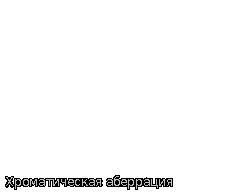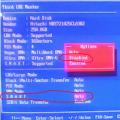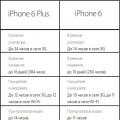Sometimes people ask me what distance will be to the subject if I photograph with a particular lens. In this article I have developed a simple calculation formula.
If we shoot the same model with the same fifty dollars with a horizontal camera orientation, but with a Nikon DX camera (Kf=1.5), then we will need to move 5.6 meters away. And if you take into account that, in addition to the model itself, you also need to capture a little space below and above, then for fifty dollars you will need to move 7 meters away.
To use the calculation for cropped cameras, enter the width w and height h values for your camera in the formulas. For Nikon cameras DX: w=23.5 mm, h=15.6 mm. f must be taken as it is indicated on the lens without any recalculation. Basic formulas are highlighted in color. If you can’t find the value of w and h in the instructions, then usually w=36/Kf, h=24/Kf, where Kf is the camera value.
It is very easy to find out the focusing distance to the object from the photograph you have already taken. To do this, just check the photo using http://regex.info/exif.cgi (The site supports any photo formats)
![]()
An example of how regex works. The value 'At 60cm' indicates that the photo was taken from a distance of 60cm.
Thank you for your attention. Arkady Shapoval.
Vanity doesn’t allow me to keep silent about this, so I’ll put it here too)
And at the same time, I would recommend the community - it is aimed at beginners in photography who want it, i.e. photography, master) We do homework together, discuss, criticize, write lessons and educational programs)
Read the rules and join!
In this lesson we will learn how to decipher lens markings and talk in detail about what focal length is and how it affects the image.
*1. Lens specifications*
So, let's take a look at our lenses, or rather at the markings written on their rim.
What interesting things can we see there, besides the name of the manufacturer? Here are some interesting numbers:
17-55 f/2.8
55-300 f/4.5-5.6
50mm f/1.4
So the first numbers are focal length(FR). Lenses come with variable and constant PR.
In the examples above, "17-55" and "55-300" are lenses with variable focal length. This means that the FR of the first lens can change from 17mm (at the “short” end) to 55mm (at the “long” end). In common parlance, changing the focal length of a lens is called zoom.
A 50mm lens is a prime lens. This means that this lens does not have a “zoom” and if you want to change the framing of the photo, move closer or further from the subject, you will have to do it with your own feet :)
It is believed that lenses with constant phase response give a better picture, this is due to the fact that adding a zoom “opportunity” complicates the design of the lens. Consequently, either the price of such a lens increases, or the quality decreases slightly. But, naturally, this is not an ironclad rule, and the difference in quality can often only be noticed by a trained eye, and even then at 100% crop.
The following numbers on the lens, which usually go through f/, indicate the maximum f/number, which can be set on the lens.
In the examples above, f/2.8 means that the maximum aperture can be opened to a value of 2.8, while the maximum aperture opening does not depend on the focal length.
For example, on a 55-300 f/4.5-5.6 lens, the opening of the aperture depends on the focal length. Those. at a focal length of 55mm, the aperture opens to f/4.5, and when the zoom is increased to 300mm, the aperture can only be opened to f/5.6.
*2. Focal length*
Let's now see what focal length is and what it affects.
*2.1 Frame*
Naturally, the most obvious use of focal length is cropping.
At low FR values, a large area falls into the frame, and the viewing angle is very wide. Therefore, lenses with a short focal length are called wide angle(“widths”), 18-24mm. Such lenses are typically used for landscape photography.
Lenses with a very short focal length (10-12mm) are called fish eye, their viewing angle can reach almost 180 degrees, but the pictures turn out almost caricatured, with insane perspective distortions.
The longer the focal length, the smaller the viewing angle of the lens, the less space gets into the frame. At the same time, the image “gets closer”. Lenses with very long focal lengths are called telephoto lenses(200-300mm and more), such lenses are used for photographing wildlife, athletes on the football field, i.e. in cases where you can’t get close to the subject of shooting.
Lenses with an AF of 35-50mm are usually classified as universal lenses, so-called staff members, i.e. suitable for shooting a variety of scenes. Such lenses are called standard lenses because they are most often worn without removing them from the camera, for all occasions. Naturally, each person can have his own staff, depending on his preferences.
Lenses with focal lengths of 50-125mm are best suited for shooting portraits, and they can roughly be classified as "portrait painters", since they give the least perspective distortion.
To illustrate this more clearly, I will give 2 pictures. Both pictures were taken from the same shooting point. But on the first focal length = 18mm, and on the second - 70mm. As you can see, at 18mm almost the entire room was included in the frame, but at 70mm the image was “closer” and only the person fit into the frame.
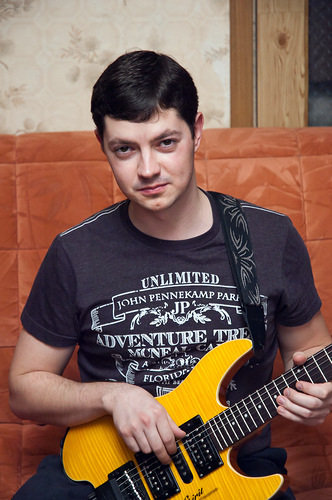
(note: the pictures have little artistic value and were taken solely for the purpose of illustrating differences in focal lengths)
*2.2 Perspective distortion*
Perspective distortion is a distortion of the proportions of the subject being photographed.
These distortions appear when the camera is very close to the subject being photographed.
Thus, the further we move away from the subject, the less perspective distortion we get.
Now let's see what focal length has to do with it.
Let's say we need to take a facial portrait of a person. If we use a small focal length, then in order to get only the face into the frame, without the surrounding environment, we will have to get very close to the subject, which will cause terrible perspective distortions. We will get not a portrait, but a caricature.
The more we increase the focal length, the further we will need to move away from the subject, and accordingly, the less perspective distortion will be.
It is believed that when shooting portraits, it is best to use lenses with a focal length of at least 50mm. (However, in photographic circles there is a constant debate on the topic “Fifty dollars is not a portrait!” And indeed, a front portrait at 50mm will have slight perspective distortions. But, for example, a half-length portrait will be quite good)
In general, a classic portrait lens is an 85mm fast lens :)
Again, a few photos as an example.
1 photo - 18mm - a completely caricatured image, the person being portrayed will rarely like this result :)
2 photos - 35mm - better, but distortion is still noticeable;
3 photos - 70mm - and very close to the truth.
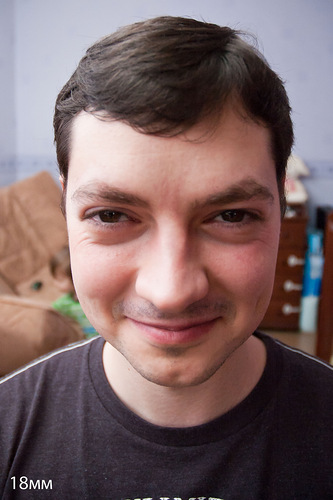


*2.3 Exposure and focal length*
The higher the focal length, the shorter the shutter speed needs to be set to avoid “shake” (blurring of the frame due to shaking hands). Do you think your hands aren't shaking? Try putting a 300mm lens on your camera and looking through the viewfinder, you will be surprised :)
To approximately determine the required shutter speed, you can use the formula -
[shutter speed] = [unit] divided by [focal length].
Those. with a focal length of 18mm, a shutter speed of 1/18 is sufficient, and with a focal length of 200mm, the shutter speed should be reduced to 1/200.
*2.4 Crop factor*
When talking about focal length, one cannot fail to mention the “crop factor”.
The reference matrix size is considered to be the size of a standard 35mm film frame.
Digital cameras with a matrix the size of a 35mm film frame are called “full frame”. Cameras with a matrix size smaller than 35mm film are cropped.
At the same time, the lenses will give a slightly different picture on a cropped and full-format matrix: the focal length of the lens will “increase” in proportion to the crop factor of the matrix.
Those. If we have a 50mm lens, then using it on a camera with a crop factor of 1.5, we will get an image similar to that obtained when shooting with a 75mm lens on a “full frame” camera.
*3. Diaphragm*
When shooting a portrait, we all want to get a three-dimensional, vibrant image.
First of all, of course, this is achieved by a light-shadow pattern. But don’t forget about depth of field - a correctly selected depth of field allows you to separate the portrait from the background, making the photo multifaceted and deep.
As we all remember, it is the aperture that allows you to adjust the depth of field. Opening the aperture to its maximum will allow you to leave only your eyes in focus, leaving the rest of the image in a beautiful watercolor bokeh.
I admit, I love the most blurry portraits. and not only portraits, to be honest, I’m just a fan of blur :) But, of course, such extreme solutions are not at all necessary, you can close the aperture so much that the entire subject is clear, but a beautiful bokeh in the background will always decorate a portrait) The main thing is to watch out so that the eyes are in focus, this is the center of any portrait

*4. Exercise*
The tasks were written for community members, but what if any of you also want to complete them for fun?) Let us know the results in the comments)
1. Study the lenses you have, find the lens with the smallest DF. Using a wide-angle lens, shoot an “interior portrait” or “landscape portrait”; in the photo, try to convey the ratio of scales, volume and spaciousness of the space surrounding the subject.


2. Shoot a portrait using the longest focal length on your lens and the widest aperture. Vary the opening of the aperture to achieve the degree of blur that suits you best. Remember that the eyes must be in focus)

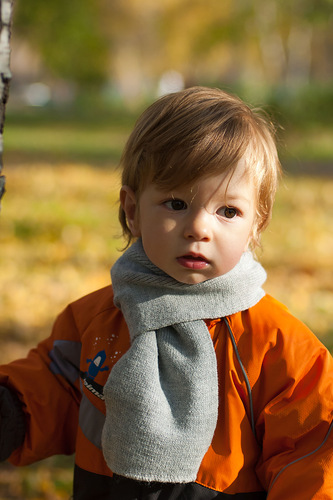
3. And I suggest you have a little fun :) Take a portrait, setting the smallest focal length, getting as close as possible to the subject (by the way, a “hand-held” self-portrait is just from the same opera). Achieve maximum perspective distortion and caricature look :)


© 2016 site
APS-C format (red frame) in front of the full 35mm frame.
When working with most digital cameras (with the possible exception of full-frame models), the photographer is constantly forced to take into account such a parameter as crop factor photo matrices, as well as a concept closely related to the crop factor equivalent focal length. These concepts take on special practical significance when it comes to comparing cameras various formats, as well as lenses designed for these cameras.
In most digital cameras, the dimensions of the photosensitive matrix are smaller than the dimensions of a standard frame of small-format 35 mm film. Only full-frame cameras have a sensor whose size coincides with the size of a traditional film frame, i.e. 36 x 24 mm.
The relationship between the linear dimensions of a full 35 mm frame and a reduced format frame is called crop factor(from English to crop– trim). In other words, the crop factor tells us how many times the matrix of the camera in question is smaller than a full-frame sensor. The smaller the matrix, the greater its crop factor, and vice versa.
Since the aspect ratio of the frame may vary in different systems, the length of the diagonal of the working area of the photo matrix is usually used to calculate the crop factor. Thus, the crop factor is equal to the ratio of the diagonal of the full frame (43.3 mm) to the diagonal of this particular sensor.
Below are crop factor values for the most common digital formats:
| Crop factor (Kf) | Frame dimensions | Diagonal | Examples | |
| 1 | 36 x 24 mm | 43.3 mm | Full frame: 35mm film, Nikon FX, Canon Full-frame, Sony α A7, Leica M, Pentax K-1. | |
| 1,3 | 27 x 18 mm | 33.3 mm | Sigma sd Quattro H, as well as the discontinued Canon APS-H. | |
| 1,5 | 24 x 16 mm | 28.9 mm | Standard APS-C: Nikon DX, Pentax K, Fujifilm X, Sony α NEX, Samsung NX, Sigma sd Quattro. | |
| 1,6 | 22.5 x 15 mm | 27.1 mm | Canon APS-C. | |
| 2 | 18 x 13.5 mm | 21.7 mm | 4/3" format (Micro 4/3 System): Olympus, Panasonic. | |
| 2,7 | 12.8 x 9.6 mm | 16 mm | 1" format: Nikon 1, Nikon DL, Canon GX, Sony DSC-RX100, Samsung NX Mini. | |
| 4,5 | 7.6 x 5.7 mm | 9.5 mm | Format 1/1.7" | Numerous soap dishes |
| 6 | 6.2 x 4.6 mm | 7.7 mm | Format 1/2.3" | |
Compact digital cameras(otherwise known as point-and-shoot cameras), in order to reduce cost and size, but at the expense of image quality, are equipped, with rare exceptions, with small sensors with a crop factor in the region of 3-8. A lens with a focal length of 8 mm will be normal for a sensor with a crop factor of 6. For cameras built-in mobile devices, sensors are usually very tiny, and crop factors can even be double digits.
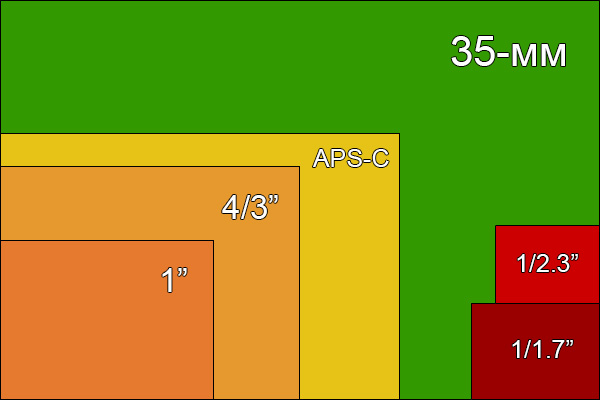
Comparative sizes of small format photo matrices.
Equivalent focal length
Let's assume that your camera sensor measures 24 x 16 mm (APS-C format). The linear dimensions of such a sensor are 1.5 times smaller than the dimensions of the full frame (36 x 24 mm), which means its crop factor is 1.5. The diagonal of the APS-C matrix is approximately 28.9 mm, i.e. again, 1.5 times less than the diagonal of the full frame, which, as already mentioned, is 43.3 mm. We remember that a standard or normal lens is considered to be a lens whose focal length is approximately equal to the diagonal of the frame. For example, a lens with a focal length of 50 mm on a full-frame camera can be considered standard. But as soon as you install the same lens on an APS-C format camera, it turns out that now the focal length of the lens is significantly longer than the diagonal of the frame, i.e. the lens has turned from normal to long-focus. Moreover, the image angle of the lens has also decreased in proportion to the reduction in the size of the matrix, and now corresponds to the image angle of a long-focus lens. Why does this happen?
Of course, when changing the camera, the true focal length of the lens did not change and could not change. The image angle has changed. Focal length is a characteristic that relates solely to the lens. It does not depend in any way on the camera on which it is installed or on the size of its sensor. But the image angle depends both on the focal length of the lens and on the size of the matrix.
For the convenience of describing the operation of lenses on cameras with different photosensor sizes, the artificial term “ equivalent focal length"(EGF), describing the apparent increase in the focal length of the lens due to a decrease in its image angle when using a matrix with a crop factor. Equivalent focal length indicates what lens would need to be used when shooting full frame to get the same image angle as the existing lens when shooting on a camera with a smaller format sensor.
The equivalent focal length is equal to the true focal length (FR or ƒ ), multiplied by the crop factor (K f). For example, a lens with a focal length of 35 mm in conjunction with the above-mentioned sensor with a crop factor of 1.5 will have an equivalent focal length of 53 mm, i.e. will turn into a standard lens. A zoom lens with a focal length range of 18-55 mm, which is equipped with many amateur cameras, has a variable equivalent focal length of 27-84 mm, and therefore is a practical universal lens, capturing both wide-angle and moderately long-focal ranges. For full-frame cameras, the crop factor is, as you might guess, 1, and the equivalent focal length corresponds to the real one.
The phrase “equivalent focal length” itself should not mislead you. Two lenses installed on cameras of different formats and having the same equivalent focal length, only and exclusively the image angle will be truly equivalent. Equivalence in this case does not apply to aperture, bokeh, depth of field, etc. These parameters depend on many factors and therefore may or may not coincide for different lenses. Conversely, when using the same lens on different cameras, the change in the equivalent focal length will only be expressed in a change in the image angle. All other lens parameters (including its true focal length) remain unchanged.
Correspondence between true and equivalent focal lengths for sensors with different crop factors
| FR, mm | EGF, mm for the corresponding crop factor |
||
| 1,5* | 1,6** | 2 | |
| 10 | 15 | 16 | 20 |
| 14 | 21 | 23 | 28 |
| 16 | 24 | 26 | 32 |
| 18 | 27 | 29 | 36 |
| 20 | 30 | 32 | 40 |
| 24 | 37 | 39 | 48 |
| 28 | 43 | 45 | 56 |
| 35 | 53 | 57 | 70 |
| 40 | 61 | 65 | 80 |
| 50 | 76 | 81 | 100 |
| 55 | 84 | 89 | 110 |
| 60 | 91 | 97 | 120 |
| 70 | 107 | 113 | 140 |
| 85 | 129 | 138 | 170 |
| 100 | 152 | 162 | 200 |
| 105 | 160 | 170 | 210 |
| 135 | 206 | 219 | 270 |
| 200 | 305 | 324 | 400 |
| 300 | 457 | 486 | 600 |
| 400 | 609 | 648 | 800 |
| 500 | 762 | 810 | 1000 |
| 600 | 914 | 972 | 1200 |
| 800 | 1219 | 1296 | 1600 |
* Usually not 1.5, but 1.52.
** Actually – 1.62.
I'm not giving numbers here for compact cameras, because there is a huge variety of formats among them and my table would take up too much space. Look at the specifications of your camera to find out the sensor dimensions, and try to calculate the EGF values you are interested in yourself. I also pass by equipment larger than a 35mm digital SLR camera, the coping factors of which, as you might guess, less units. I believe that if you shoot in medium format, and even more so in large format, then most likely you no longer need my modest help.
Lenses for cameras with crop factor
Lenses designed for small-format film cameras, as well as digital full-frame cameras, are designed in such a way that the image circle projected by the lens completely covers the working part of the frame. Obviously, when using smaller sensors, there is no need for such a large image circle. In this regard, photographic equipment manufacturers that produce cameras with a crop factor also produce lenses corresponding to these cameras with a reduced image circle. Such lenses are lighter, more compact and cheaper than traditional format lenses, but they are not designed for use with full-frame cameras, since the corners of the frame will turn out black due to the small image circle. In turn, full-frame lenses can be used on both full-frame and cropped cameras (subject to mechanical compatibility), in the latter case making only an adjustment for changes in the equivalent focal length.
It should be emphasized that regardless of what format the lens is intended for, it almost always indicates true, and not at all the equivalent focal length. EGF is not a constant value, since it depends on the camera on which the lens is installed, i.e. equivalent focal length not a characteristic of the lens, but rather characterizes the lens + matrix system as a whole.
Thank you for your attention!
Vasily A.
Post scriptum
If you found the article useful and informative, you can kindly support the project by making a contribution to its development. If you didn’t like the article, but you have thoughts on how to make it better, your criticism will be accepted with no less gratitude.
Please remember that this article is subject to copyright. Reprinting and quoting are permissible provided there is a valid link to the source, and the text used must not be distorted or modified in any way.
Understanding the features of lenses can help you control your creation. digital photos. Choosing the right lens for a shooting task can be a complex trade-off between cost, size, weight, focusing speed and image quality. This chapter aims to improve understanding of these choices by providing an initial overview of the concepts of image quality, focal length, perspective, prime and zoom lenses, and aperture or f-number.
Lens elements and image quality
All cameras, except the simplest ones, are equipped with lenses that consist of several “optical elements”. Each of these elements helps direct the flow of light rays to recreate the image on the digital sensor as accurately as possible. The goal is to minimize aberrations while using the fewest, least expensive elements.
Optical aberrations occur when elements in a scene do not translate into similar elements in the image after passing through the lens, creating image blur, reduced contrast, or color mismatch (chromatic aberration). Lenses may also suffer from imbalance, vignetting, or perspective distortion. Hover over each of the options below to see how these defects affect image quality in extreme cases.
 |
|
|
| Original image | Loss of contrast | Blur |
| Chromatic aberration | Distortion of perspective | |
| Vignetting | Original | |
Each of these issues is represented to some degree in any lens. Later in this chapter, when a lens is referred to as having poorer optical quality than another lens, it means some combination of the defects described above. Some of these defects may be less objectionable than others, depending on the subject being photographed.
Effect of lens focal length
The focal length of the lens determines its angle of view and at the same time the degree of magnification of the subject at a given shooting point. Wide-angle lenses have short focal lengths, while telephoto lenses have long focal lengths.

Note: The point where the light rays intersect is not necessarily equivalent to the focal length as shown above, but the distance is approximately proportional. Thus, increasing the focal length actually reduces the angle of view, as illustrated.
Many will say that the focal length also determines the perspective of the image, but strictly speaking, the perspective only changes with the change in the position of the photographer relative to the subject. If you try to shoot the same subject with a wide-angle lens and a telephoto lens, the perspective will actually change as the photographer will have to move closer to or further away from the subject. Only in these cases will a wide-angle lens exaggerate or stretch the perspective, while a telephoto lens will compress or smooth it out.
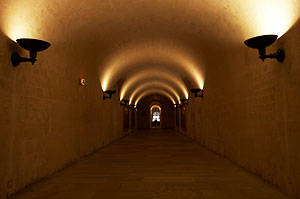
Controlling perspective can be a powerful compositional tool in photography and often determines the choice of focal length (if it is possible to shoot from any position). Hover over the image above to see the shift in perspective due to the wide angle. Note that the objects in the frame remain almost identical and thus require a closer position for the wide-angle lens. The relative sizes of objects change so much that the distant door becomes smaller relative to the lamps in the foreground.
The following table provides information on what focal lengths are needed for a lens to be considered a wide-angle or telephoto lens, as well as their typical uses. Please note that Only approximate focal length ranges are indicated, and actual application may vary accordingly; many, for example, use telephoto lenses when shooting long landscapes to compress the perspective.
*Note: Lens focal lengths are valid for cameras with sensor size equivalent to 35mm film. If you are using a compact or budget DSLR camera,
Most likely, the sensor size in it is different. To correct these numbers for your camera,
use the focal length converter in the chapter on digital camera sensor sizes.
Other factors may also depend on the focal length of the lens. Telephoto lenses are more sensitive to camera shake because minimal hand movement results in significant image shifts, as you can see if you try to hold a pair of binoculars with shaky hands while zooming in. Wide-angle lenses generally have less glare, in part because they were designed with the understanding that wide angles are more likely to let the sun into the frame. Finally, closer telephoto lenses generally provide better optical quality at a similar price.
Focal length and handheld shooting
The focal length of a lens can also have a significant impact on the ease of getting a sharp handheld shot. Increasing the focal length requires shortening the shutter time to minimize blur caused by hand shake.

Imagine what it’s like to hold a laser pointer motionless: its beam jumps noticeably less on a nearby object than on a distant one.

This is because the slightest circular vibrations increase significantly with distance, whereas if the vibrations were only horizontal or only vertical, the distance from the laser to the object would be maintained. A generally accepted rule of thumb for determining the required shutter speed for a given focal length is dividing unit per focal length
. This means that for a 35 mm camera, the exposure time should be no more than one divided by the focal length, a fraction of a second. In other words, when using a 200mm focal length on a 35mm camera, the shutter speed should be no more than 1/200 of a second, otherwise it will be difficult to avoid blur. Do not forget that this is an extremely rough rule; someone will be able to hold the frame much longer or, conversely, less. Owners of digital cameras with a smaller sensor will have to calculate the effective (true) focal length taking into account the frame size.
A variable lens is one whose focal length can change within specified limits, whereas in “simple” or fixed lenses it is unchanged. The main advantage of a vari lens is the ease of achieving a variety of compositions or perspectives (since there is no need to change lenses). This advantage is often critical for dynamic shooting, for example, in photojournalism and children's photography.
Do not forget that Using zoom doesn't necessarily mean you don't need to move anymore; zooms just increase flexibility. The example below shows the starting position as well as two options for using a zoom lens. If a simple lens were used, changing the composition would not be possible without cropping the image (if the composition needed to be closer). Similar to the example in the previous section, the change in perspective was achieved by shortening the focal length and moving closer to the subject. To get the opposite change in perspective, you would have to increase the focal length and move further away from the subject.
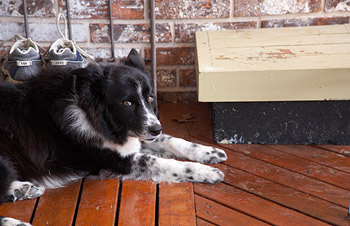 |
|
| Two varifocal lens options: | |
| Changing the composition | Changing Perspective |
Why deliberately limit your capabilities by using a simple lens? Prime lenses existed long before the advent of vari lenses and still have many advantages over their more modern counterparts. When zooms first came to market, using them meant sacrificing a lot of optical quality. However, newer, high-quality vari lenses generally do not introduce any noticeable deterioration in image quality unless scrutinized with a trained eye (or when printing a very large print).
The main advantages of prime lenses are cost, weight and speed (aperture). Inexpensive prime lenses can usually provide just as good (if not better) image quality than expensive vari lenses. Additionally, if we're looking at a zoom with a small focal length range, a prime lens with a similar focal length will be significantly smaller and lighter. Finally, the best prime lenses almost always provide better aperture (maximum aperture) than the best zooms - which can sometimes be critical for low-light sports or theater photography where a shallow depth of field is needed.
For compact digital camera lenses that say 3x, 4x, etc. zoom, this number refers to the range between the shortest and longest focal lengths. So a higher number doesn't necessarily mean the image can be zoomed in further (as that zoom might simply have a wider angle at its minimum focal length). In addition, digital zoom is not the same as optical zoom, since it enlarges the image through interpolation. Read the fine print to make sure you are not misled.
Effect of aperture or f number
The aperture stop range of a lens refers to the degree to which the lens can be opened or closed to let in more or less light, respectively. Apertures are specified in terms of f-numbers, which quantify the relative area of light transmission (shown below).

Note: This comparison is approximate: the aperture blades rarely form
a perfect circle, since the aperture usually consists of 5-8 blades.
Keep in mind that the larger the light transmission area, the smaller the f-number (this is often confusing). The two terms are often mistakenly used interchangeably. The remainder of this article considers lenses as apertures. Lenses with wider apertures are often called "faster", because the same ISO sensitivity may require a faster shutter speed for the same exposure. Additionally, a smaller aperture means that objects can remain in focus over a greater range of distances, a concept described by the term "depth of field".
When purchasing lenses, pay attention to the specifications, which indicate the maximum (and sometimes minimum) possible aperture. Lenses with large aperture ranges provide greater flexibility in both possible shutter speed and depth of field. The maximum aperture is probably the most important characteristic lens and is often indicated on the box along with the focal length.
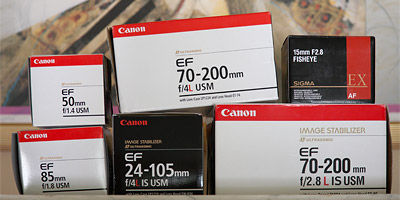
The f number can also be specified as 1:X (instead of f/X), as in Canon lens 70-200 f/2.8 (its box is shown above and it says f/2.8).

Shooting portraits, as well as in the theater or at sports events, often requires the lens to have the largest possible apertures to achieve fast shutter speeds or shallow depth of field, respectively. Shallow depth of field when shooting a portrait helps to separate the subject from the background. For digital cameras Lenses with larger apertures produce a significantly brighter viewfinder image, which may be critical for shooting at night and in low light conditions. They often also provide faster and more accurate autofocus in low light conditions. Manual focusing is also easier, because the viewfinder image has a shallower depth of field (making it easier to see when the subject comes into focus).
Minimum lens apertures are usually not nearly as important as maximum apertures. They are rarely used due to image blur caused by diffraction, and because they can require impossibly long shutter speeds. In cases where extreme depth of field is needed, lenses with a smaller maximum aperture (large f-number) can be used.
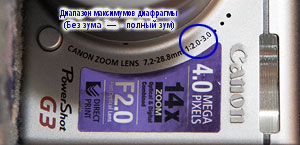
Finally, some zooms on DSLRs and compacts digital cameras the range of maximum apertures is often indicated, since the aperture value can depend on the focal length. These aperture ranges only define the maximum apertures possible, not the full range. For example, f/2.0-3.0 means that the maximum possible aperture gradually decreases from f/2.0 (at the widest angle) to f/3.0 (at the maximum focal length). The main advantage of a variable lens with a constant maximum aperture is that exposure is more predictable regardless of focal length.
Please also note that even if a lens' maximum aperture cannot be used, this does not necessarily mean that the lens is not needed. Lens aberrations are typically smaller when exposures are used one or two f-stops below maximum aperture (for example, when using f/4.0 on a lens with a maximum aperture of f/2.0). This Maybe mean that for photography at f/2.8 aperture, an f/2.0 or f/1.4 lens can achieve more High Quality than a lens with a maximum aperture of f/2.8.
Other considerations include price, size and weight. Lenses with large maximum apertures are usually much heavier, larger, and more expensive. Size and weight can be critical for wildlife photography, hiking and travel, where equipment must be carried for long periods of time.





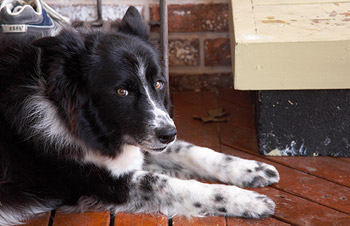

Today we have a question that is firmly overgrown with legends and myths. It usually comes up immediately after statements like: “They advised me to buy a fifty-kopeck piece, because on my crop it will be a good portrait lens, because its focal length will already be 80mm! Is not it so? And then...”
#19 How is the crop factor of the sensor related to the focal length of the lens?
I would like to say right away that any lens with which you are used to shooting portraits can become a “portrait lens”. If these photographs are liked by those to whom they are addressed, then why not?..
But formally, 50 mm mounted on 35 mm format equipment is most likely not portrait lens, but, nevertheless, simply universal. It is suitable for all types of photography - from landscapes to portraits. But when photographing faces close-up, it gives noticeable perspective distortions (the nose is larger than it is perceived visually, the eyes are smaller, the ears are farther away and even smaller). That is why, for the 35 mm standard, technicians for portrait purposes try to choose lenses with focal lengths greater than 50 mm. And here it becomes important - will a camera with a crop matrix transform a lens with a focal length of 50 mm into something longer focal length?
In general, I will traditionally, under the cut, answer this question briefly and in detail.
Short version:
If we talk only about the technical part, then the fact that you put a full-frame lens with a focal length of, for example, 50 mm on a camera with a crop matrix, its focal length will not change in any way. As it was 50 mm, it will remain so. “Fifty dollars” will remain “fifty dollars” on both the Canon EOS 5DmkII and the Canon EOS 1100D.
But the crop factor will force you to shoot from a greater distance so that everything that fits in the frame on a full-frame camera fits into the frame. And then you will be forced to move away from the subject at such a distance as as if You have a lens with a focal length larger by the crop factor (focal x crop factor).
That's it in short. I’ll answer in detail below.
Expanded answer:
First, you will need to fuck a little and load up on diagrams and definitions:
1.
Focal length
The distance along the optical axis from the second principal point of the lens (back nodal point) to the focus when a parallel beam of rays enters the lens parallel to the optical axis is called the focal length. All clear? =:)Okay, simply put, the focal length is the distance from the main point of the lens to the matrix (when the lens is focused at infinity):
Where in the lens is this “second” actually located? main point" - only the designers themselves know. By the way, in some cases it may be outside the lens body, as I understand it. But this is not so important.
The focal length of the lens itself does not mean anything; it is a technical term that photographers are accustomed to using in much the same way as ordinary people use the concept of “horsepower” to determine the power of motors. What horse? What kind of power? Does anyone even remember the textbook definition of what “horsepower” is? Not to mention the fact that in Europe and America, for example, these forces are not the same.
Much more important for photographers is that focal length directly affects the viewing angle of the lens.
2.
Viewing angle
This very viewing angle is important for photographers because it is what affects perspective distortion:
If the angle is wide, then the distortion will be more noticeable, if it is narrow, then less. Using a portrait as an example: a person’s nose and ears are approximately the same size. If you shoot a portrait with a wide-angle lens, the nose will appear noticeably larger than the ears. And if long-focus, then they will be closer to each other in size.
That is, the angle of view of the lens is an indicator of the “perspective curvature” of the photograph, to put it quite figuratively. =:) And for photographers it is more important than the focal length, because on cameras of different formats the same focal length of the lens will correspond to different angles of view:
Thus, on 35 mm technology, a lens with a focal length of 50 mm will be a moderate telephoto lens, on a medium format it will already become wide-angle, and on a point-and-shoot camera it will become an ultra-long-focus lens.
3.
Crop factor
Now, what is this notorious crop factor? This is a marketing decision that arose primarily due to the fact that it is more profitable (cheaper) to produce smaller matrices than to produce full-format (or simply large) sensors. The most common solutions today look like this:
For convenience, we introduced a numerical value for the crop factor - how many times the diagonal of the sensor in the camera is smaller than the diagonal of the reference full-size frame of a film camera (36 x 24 mm). If the crop factor is, for example, 1.6, then this means that the diagonal of the sensor in the camera is 1.6 times smaller than the diagonal of a full-size one. Cameras with matrices whose size is smaller than a full frame began to be called “cropped”.
Well, after all this, let's see how lenses with “cropped” cameras work. If the lens is a regular, full-size one (designed to work with both cropped and full-frame cameras), then this is what happens:

The lens honestly forms an image circle with a diameter of 43.2 mm, so that a full-size frame (36 x 24 mm) can be fit into it. But the camera has a smaller, cropped sensor. Therefore, only the central part (circled in blue) of the entire generated frame will be remembered on the flash drive. And this central part will have all the perspective distortions of a given viewing angle.
Whether the sensor is cropped in the camera or full-size, it makes no difference to the lens system. The focal length will not change, it will remain the same because it is design feature of this particular lens. And 50 mm will remain the same on a 50 mm crop. That is, “fifty dollars” mounted on a cropped camera will not physically become a lens with a focal length of 80 mm. And the depth of sharply displayed space, by the way, in this “fifty-kopeck” will remain characteristic of a lens with a focal length of 50 mm.
And if you use a full-size lens with one focal length on a full-frame camera and at the same time on a cropped one, then the pictures in their central part will look absolutely identical in their geometric distortions:


Focal lengths do not change. Is the fairy tale over? But no.
In order to get exactly the same coverage with the same lens as on a full-frame camera, the owner of a cropped camera will have to move a greater distance. With a cropped matrix, everything will fit into the frame only when its owner moves so far away, as if he does not have a designated focal length (let’s say the same 50 mm), but the crop factor is times larger (50 mm x 1.6 for APS -C = 80 mm).
The lens will remain with a focal length of 50 mm. But the same scene that fit entirely on a full-frame sensor will now only fit when the photographer moves away from the subject at a distance as if he had an 80mm lens. The words “as if” are very important here, as you understand.
And when the photographer moves away from the subject, he will receive other perspective distortions (due to a more flattened passage of rays through the lens). Simple example to understand last point. If you take a wide-angle lens and photograph a person's face so that it occupies the entire frame, you will be able to see strong geometric distortion:

But if you shoot with the same lens from a greater distance, so that the face occupies only part of the frame, then exactly the same distortions will no longer be so noticeable:

The following conclusions can be drawn from all this:
focal lengths of full-frame lenses mounted on cameras with crop sensors, remain unchanged; the presence of a crop factor narrows the angle of view of lenses and makes them according to this indicator equivalent longer focal length lenses.


